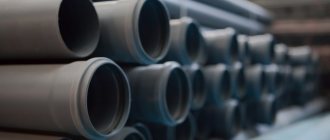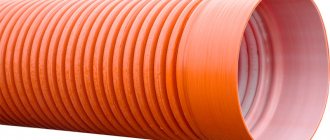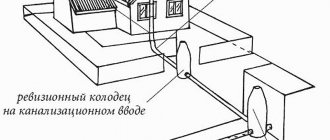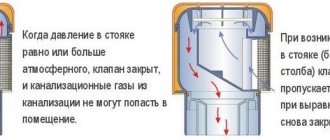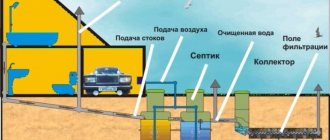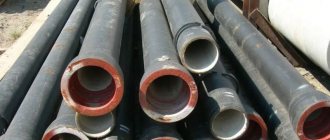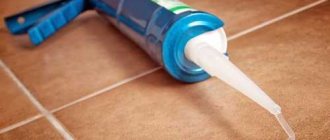A huge range of sewer pipes made of different materials often leads the end user to a dead end. Products made from polyvinyl chloride (PVC) are in greatest demand, but you can often see the abbreviation UPVC in pipe markings.
It is the extra letter “N” that makes many people think. So how do pipes made from the familiar PVC differ from uPVC, and what kind of material is it? Let’s look into this article.
PVC-U sewer pipe for external and internal networks
Currently, the main material for the production of pipes is unplasticized polyvinyl chloride - uPVC.
Over the course of its half-century history, the uPVC sewer pipe, invented in Germany, has undergone significant changes in its production technology.
The use of innovative developments and modern technologies allows us to produce more advanced communications with high quality indicators and technical characteristics.
↑
note
Depending on the complexity of the technological process, single-layer or three-layer polyvinyl chloride pipes are produced.
The three-layer structure provides the products with high wear resistance thanks to the outer layer of unplasticized polyvinyl chloride and the inner layer of recycled foam material.
Depending on the degree of rigidity, PVC-U pipes for external sewage systems are divided into three classes:
- L – has medium hardness indicators – up to 2 kN/m².
- N – has normal stiffness indicators – 4 kN/m².
- S - thick-walled pipes, have a high degree of rigidity - 8 kN/m².
In order to select the most optimal communications option for operation in certain geographic and climatic conditions, it is necessary to select products that have a certain degree of rigidity.
For example, pipes of classes L and N have a small wall thickness; accordingly, they can be laid in the ground to a shallow depth - from 0.8 to 6 meters. At the same time, thick-walled class S pipes are an ideal solution for arranging an external sewer system at a depth of up to 80 cm and more than 6 meters.
Depending on the location of the object and the degree of load in the construction area, PVC-U pipes are divided into light, medium and heavy:
- In places with light load (for example, in pedestrian and green areas), pipes of the light type are used.
- In places where little traffic is planned, medium-type pipes should be laid.
- In industrial and densely populated areas that involve constant heavy traffic loads, it is necessary to lay heavy-duty pipes. Moreover, such communications can be laid even at a depth of up to 8 meters under highways.
Depending on the connection method, PVC-U pressure sewer pipes are produced with or without a socket. To connect structures that do not have a socket, modern fitting elements or adhesive technologies are used.
↑
Based on the purpose and scope of application, PVC-U sewer pipes are used for internal and external networks.
These types of communications can be used under certain conditions:
- temperature regime should be from 0 to 450C;
- transportation of water and other liquid and gaseous media is carried out under pressure;
- It is possible to transport chemically aggressive media, including acids (nitric, hydrochloric, phosphoric, sulfuric), milk, mercury, petroleum, wines, oils and other aggressive substances.
The main advantages of uPVC pipes for sewage systems of various systems are high wear resistance, low probability of clogging and overgrowth, excellent aesthetic properties, safety and environmental friendliness of the material, ease of installation.
As a rule, gray PVC-U sewer pipes are intended for the installation of internal sewerage systems for pipelines for various purposes. They are made from high quality unplasticized polyvinyl chloride, gray in color. The diameter of this product ranges from 50 to 250 mm.
PVC-U pipes for internal sewerage are produced in gray color
For the installation of external non-pressure systems of structures and buildings, brown PVC-U pipes for sewerage are used. Their diameter is 110-500 mm.
The undeniable advantage of this type of product is:
- high dimensional stability and hardness.
- ease of installation and installation without the use of special equipment and techniques determines the quite affordable cost of professional services for this type of work;
- resistance to alkalis and acids and other chemical compounds even when operating communications at elevated temperatures;
- the presence of a smooth inner surface completely eliminates the formation of deposits of various types of contaminants, since the product has a high degree of self-cleaning. Accordingly, the financial costs of servicing these communications during their operation are significantly reduced, since additional flushing and removal of blockages from such communications will not be required;
- high levels of anti-corrosion properties (including against aggressive external influences), which makes it possible to lay communications in the ground without the use of additional methods of insulating them.
Source: https://VseTrybu.ru/truba-npvx-kanalizacionnaya.html
PVC pipes for installation of external sewerage
“Classic” concrete and ceramic pipes are being replaced by PVC products. The main advantages of PVC plastic pipes are ease of installation and maintenance, resistance to external and internal loads, and long service life. Orange sewer pipes of class SN4 and SN8 have the following advantages:
- Light weight of pipes (especially compared to concrete and metal options). This greatly simplifies installation and makes it possible to use the structures on objects of any type.
- Chemical resistance. Polyvinyl chloride is not afraid of many aggressive liquids and gases. The products can be used both for the removal of domestic wastewater and for use in chemically contaminated environments.
- Resistance to abrasion and other types of loads. Thanks to this, the service life is many years.
- Heat resistance. The structures are suitable for transporting substances whose temperature exceeds 60 °C.
- Ease of transportation and operation.
Scope of application
Purpose of SN4 pipes and installation of free-flow sewerage systems - the pipes are suitable for use for sewerage to private homes, industrial facilities, as well as for transporting wastewater. Most often, the following designs are created using such products:
- external sewer networks;
- intra-block external sewerage networks;
- wastewater disposal systems.
Due to their high ring rigidity, the products can be used in places with high loads, for example, under highways, at airports, where the ground is regularly exposed to intense impact from heavy objects. The structures are well suited for domestic and industrial premises.
What to look for when choosing
The main characteristic of pipes is ring stiffness. It determines what loads the product can withstand. The indicator is indicated by a number after the SN marking. Here are the most common varieties.
- Class SN2 belongs to the light category. Designed for use in places with minimal load (where only pedestrians impact the ground).
- Class SN4 is the most versatile and common option. Withstands average traffic load.
- Class SN8 - products of this type are designed for installation in networks with high traffic load, for example, under constantly busy highways.
Important! Even the most durable type will retain its properties only if installed correctly. Installation rules must be followed. If laying is carried out in areas with traffic, a depth of at least 1.3 m is required. If cars will not drive over the pipes, 0.8 m will be enough. Installation work is carried out at a temperature not lower than -10 ° C.
To connect products into a single system, you can use fittings (couplings, bends) or the “socket” method. To simplify the second option, an O-ring is used on the socket. You can use rubber cuffs that provide additional tightness.
Sewage pipes have a unified marking of type UPVC 110/3.2 SN4, in which:
- uPVC - type of pipe;
- 110 - outer diameter;
- 3.2 - wall thickness;
- SN4 - hardness class.
Installation Features
Before starting work, check the condition of the sewer pipe socket. It must be intact (cracks and other signs of damage are not allowed). Make sure there is a rubber seal inside. To simplify the connection, silicone-based lubricant is used. Installation is carried out in several stages.
- Find the smooth end of the pipe and lubricate it with silicone grease. This will help disassemble the structure if such a need arises in the future.
- The side without the socket should be inserted into the socket until it stops. Mark where the smooth side meets the socket.
- Remove the 1 cm socketless part and save it for fixing.
PVC products can be cut to specific dimensions. An ordinary hacksaw is suitable as a cutting tool. When cutting with a hacksaw, make a chamfer at an angle of 15 degrees - this will protect the seal from damage during installation.
Strength classes
This parameter displays what load the sewer pipe can withstand; the corresponding GOST provides three categories:
- light group (marked “SN-2”) with a permissible load of 2 kN/m2. Laying in green areas, under sidewalks, flower beds, etc.;
- middle group (SN-4), for which the permissible load is 4 kN/m2. Scope of application: roads, where there is little traffic, parking lots, country houses;
- heavy group (SN-8), designed for a pressure of 8 kN/m2 (highways, industrial zones, etc.). The permissible depth for laying pipes of this type is eight meters.
External sewage system made of uPVC or polypropylene
Good afternoon, let's talk about plastic sewer pipes - they can be for external and internal sewerage.
What is the difference between external and internal sewerage?
The answer here is quite simple - the difference is in the increased rigidity of pipes for outdoor use! Sewage systems that are laid outside homes must withstand long-term exposure to a thick layer of soil and the pressure of cars passing from above. External sewerage is produced mainly from two materials - uPVC (unplasticized polyvinyl chloride) and PP (polypropylene).
Decoding the markings on pipes
Properties of uPVC pipes
- Effluent temperature up to 60°C.
- The pH of the effluents is in the range of 2-12.
- Flammability is a self-extinguishing material.
- The design pressure of connections and joints is 0.5 bar.
- Service life >50 years
Properties of PP (polypropylene) pipes
- Effluent temperature up to 80 °C.
- The pH of the effluents is in the range of 2-12.
- The design pressure of connections and joints is 0.5 bar.
- Service life >50 years.
Selection of pipe stiffness class
External sewerage can be of different classes of ring stiffness - for example, SN4 (4 kN/sq. meter) or SN8 (8 kN/sq. meter). The ring stiffness class is selected depending on the depth of the pipe and the intensity of vehicle traffic above the pipes.
If you are going to bury pipes in your garden plot to a depth of no more than 3 meters, then the SN4 pipe is suitable for you.
If you need to lay a sewer through a busy highway, where heavy trucks are constantly moving, or bury a pipe to a great depth, then an SN8 pipe is needed.
Installation of external sewerage pipes
Installation of uPVC or PP pipes is carried out in the same way as installation of internal sewerage in a room, observing the required slopes. It should be added that due to the low roughness of plastic pipes, smaller slope angles are needed than when using cast iron or concrete pipes.
To connect pipes and fittings, sockets with rubber bands are used, which ensure the tightness of the joints. Such connections, as described above, can withstand a pressure of 0.5 atmospheres or 5 meters. External sewerage pipes can be of different diameters: 110, 160, 200 or more millimeters in diameter.
For private houses and cottages, pipes with a diameter of 110 mm are most often sufficient. Watch a video on laying external sewerage:
How to choose sewer pipes????
- We pay attention to the appearance of pipes and fittings - they must be smooth without chips or cracks.
- The bells must be round! Otherwise, the installation of such pipes will be long and difficult.
- Don’t forget to look at the marking for the ring stiffness class - it should be SN4 or SN8.
- Pay attention to the thickness of the pipe wall, it must be at least 3.2 mm.
Using these simple rules, you can easily choose the product you need.
Source: https://znayteplo.ru/kanalizacia/kanalizacionnye-truby-i-emkosti/naruzhnaya-kanalizaciya-iz-npvx-ili-polipropilena/
Marking features
In the interests of consumers, manufacturers are required to label plastic pipe products. It is placed every meter of the product, applied either with special paint or with a heated tool.
State standards define the mandatory information to be displayed on the product:
- Product designation.
- Name of the material.
- Standard sizes.
- SDR.
- Hardness rating.
- Number and date of the corresponding GOST.
What do the symbols on the label mean?
For obvious reasons, information on products is written in abbreviated form and is designated:
- In Russian letters NPVC or Latin PVC-U - name of the material;
- The nominal values of the external section and wall thickness are simply numbers in millimeters;
- SDR – normalized ratio of section dimensions to wall thickness;
- SN – ring stiffness class;
- The standard is designated by the number and year of publication of GOST.
Sample product labeling
Bend with outer section 160 mm, wall 4.9 mm:
PVC-U pipe 160×4.7 SDR 34 SN 8 GOST 32413-2013
PVC pipes for sewerage: prices and sizes
Is it possible to install a sewer system in a private house on your own? You can, for this you need to purchase PVC plumbing pipes and adapters for sewerage, and also follow all the requirements of regulatory documents for the construction of sewerage.
Long before installing the sewer system, you need to select pipes. This is a very important point, because the performance and service life of the entire sewer system will directly depend on the quality of the pipes.
Sewer pipe sizes
Typically, the sizes of PVC sewer pipes for internal sewerage come in different diameters. The most popular pipes have diameters of 32 mm, 40 mm, 50 mm, 100 mm and 110 m. In this case, the thickness of the pipe walls is selected taking into account the expected operating pressure in the sewer system and the depth of the internal sewerage.
For example, a 50 mm PVC pipe for sewerage is resistant not only to the aggressive environment of wastewater, but also to high temperatures. And the price of a 50 mm PVC pipe for sewerage is quite low. In addition, PVC pipes can withstand short-term movement of wastewater heated to 95 degrees.
Sewage pipes for internal sewerage have less thickness and rigidity compared to external sewerage pipes.
To make the installation of internal sewerage as simple as possible, PVC pipe manufacturers offer customers all kinds of parts for connections. Such parts include: tees, adapters and elbows.
The sizes and prices of PVC pipes for sewerage are influenced by customer demand and the cost of materials for their manufacture.
Plumbing connection
Before you begin installing an internal sewer system, you need to take into account the placement of all the main plumbing fixtures: toilet, shower, washing machine and dishwasher.
Taking this data into account, a pipe routing plan is drawn up, which will take into account not only the plumbing fixtures themselves, but also their dimensions and the diameter of the outlet pipes. This set of measures will greatly facilitate the installation of pipes and plumbing connections.
Of course, for connecting each type of plumbing fixture there are specific requirements, but there are also general standards that apply to all types of plumbing fixtures:
- Pipe height. At the extreme connection point relative to the riser, the height of the pipe should start at 0.8 m from the floor surface.
- Absolute coincidence of the diameter of the outlet pipe with the diameter of the sewer system pipe.
- A siphon must be installed, as it prevents the penetration of unpleasant odors from the pipe.
- The toilet must be connected exclusively directly to the riser, and the length of the pipe must be more than 1 m. In terms of installation level, it must be located at the lowest point in relation to other connections.
Absolutely all sewer joints must be sealed and be stable in the event of a powerful water hammer.
PVC pipes for internal sewerage
The purpose of the internal sewerage system is to collect contaminated water from all connected points and remove these wastewater from the premises.
What pipes are suitable for installing internal sewerage? The answer is simple, PVC pipes for sewerage have a number of advantages, due to which the choice should be in their favor.
Also, the price of PVC sewer pipes for internal sewerage is quite acceptable.
Qualitative characteristics of pipes for internal sewerage:
- Strength.
- Smooth surface allowing unhindered movement of contaminated water.
- Absolutely compatible with external sewerage pipes.
- Resistance to aggressive wastewater environments.
All of the above qualities are possessed by PVC pipes for internal sewerage, which, moreover, are very easy to install.
In general, prices for PVC pipes for internal sewerage depend on the diameter of the pipe. Therefore, before you buy PVC pipes for sewerage, you need to perform all the necessary calculations.
The production of PVC pipes is carried out from plastic compounds. PVC pipes consist of a fairly hard and very soft material. In general, the pipe has the shape of a cone, on one side of which there is a fastening socket with a rubber sealing ring. Thanks to this, no special tools are needed when performing installation work.
Step-by-step arrangement of internal sewerage
Installation of internal sewerage begins with the installation of sewer pipes in the basement, starting from the outlet pipe. Pipework needs to be done.
After the sewer pipes have been laid out, risers should be made in the basement, and its horizontal drain lines in the room.
Then installation work begins on arranging internal sewerage directly in the room.
The main rules for installing indoor sewage systems:
- You should try to install sewer pipes with a small number of connections and turns. This guarantees reliable and durable operation of the entire sewer system, because every connection is a potential site of leakage, and a turn is a site of possible clogging.
- The direction of risers and sockets of horizontal pipes should be towards the movement of contaminated water.
- The diameter of the pipes for the riser connection section is 100, 150 mm.
- To avoid repair work due to blockages, it is necessary to lay horizontal sewer pipes, maintaining an inclination angle of 4-7 cm per 1 meter.
- There must be a ventilation pipe. It warns against the penetration of unpleasant odors into the room (if installed on the roof of the house).
- Use silicone non-acid sealant, it will protect against leaks.
Cast iron
Pipes made of cast iron and ceramics can be called competitive. Cast iron has very high strength and durability. The service life of a cast iron main is at least 50 years, but the material is expensive and difficult to install.
Ceramic pipes have all the advantages. They do not rust, do not rot, are environmentally friendly, have a long service life, smooth walls prevent the occurrence of sediment sticking, but along with all the advantages they have significant disadvantages. High cost, fragility during transportation and short length, which significantly increases the number of joints in the sewer system.
PVC-U pipes for sewerage
Manufacturers make uPVC pipes for sewerage from unmodified polyvinyl chloride with additives or using special technologies to impart improved properties. The products are used in external, internal pressure and gravity systems. For the convenience of users, the outer pipes are painted red-brown, while the inner ones have a gray tint.
To confuse them, without knowing the difference in color marking, you can only have one diameter of 110 mm , and the outer pipe is perfect for the internal pipeline, the inner one will crack in winter from the cold in the external sewer. Thus, interchangeability is not complete. The same applies to fittings made of this material.
PVC-U pipes for internal sewerage
Internal sewerage uses short sections, more bends, tees, adapters, and special-purpose fittings. Siphons, audits, vacuum valves are not used in external systems. The industry produces PVC-U pipes for internal sewerage in the following sizes:
- 150, 110 mm – for risers, toilet outlets
- 110, 50, 40, 25 mm – for horizontal lines, siphons
The disadvantage of the material is susceptibility to rodent teeth (relevant for residents of private houses), release of toxic substances during melting, low operating range (-5˚С – +60˚С).
Raster connections reduce pipeline assembly time and do not require tools (except a hacksaw). Rubber rings ensure the tightness of gravity, pressure systems. When indicating the length of products, the size of the socket is not taken into account; this should be known when designing and purchasing the required quantity.
PVC-U pipes for external sewerage
Products for external systems (drainage, storm water, domestic sewage) experience significant loads and pass large volumes of wastewater through them. Manufacturers produce uPVC pipes for external sewerage in the following sizes:
- 110, 125, 150 mm – for highways
- 300 – 1,500 mm – for wells
PVC-U pipes for sewerage have an increased wall thickness compared to internal analogues of 3.2 mm. For wells, products with a wall thickness of 5–15 mm are used, since the rings experience soil pressure and heaving forces. To increase thickness, a two- or three-layer structure is used.
For the ring stiffness of pipes, the SN marking is used. In addition to autonomous sewers, products made from this material are beginning to be used in central highways. The minimum resource is half a century, although manufacturers guarantee twice as much actual operation.
Warming pipelines made of this material extends the life of the pipeline and prevents it from freezing/destruction in cold, snowless winters. Insulation is especially important for autonomous sewers, which are usually laid at a shallower depth than centralized systems.
Advice
In addition, the insulation layer performs an additional function of mechanical protection of the pipeline. Insulation can be rigid (forms are made to a certain diameter, completely enveloping the pipe) and traditional (mineral wool).
Some materials lose effectiveness when wet; they are not used in waterlogged soils, replacing them with more reliable analogues.
Source: https://aquagroup.ru/articles/truby-npvh-dlya-kanalizacii.html
Sewer pipes for external sewerage – types: red, white and waste uPVC
The system responsible for drainage is a complex engineering communication. Owners of apartments in multi-storey buildings should only worry about internal pipelines, but owners of private properties also have to think about external systems.
Sewer pipes for external sewerage must be selected carefully, since the durability and reliability of communication will depend on the choice. What products there are, what their features are, and how to choose them - we will consider below.
Requirements for external pipes
It is necessary to understand that external pipes operate in difficult conditions, for this reason high demands are placed on them.
The material from which they are made plays a significant role. It must have the following properties:
- strength;
- resistance to various aggressive environments;
- the ability to withstand seasonal temperature changes without changing its qualities;
- wear resistance.
Sewage pipes for external sewerage are made of various materials, such as plastic, steel, cast iron, ceramics and asbestos cement. All of them meet the above requirements. As a rule, we are talking about external communications, then additional requirements are added to them:
- they must withstand heavy loads (filling with soil, traffic of pedestrians and cars);
- static and dynamic effects should not affect pipes for underground installation;
- resistance to the effects of groundwater, which can lead to displacement of key components of the system and, as a result, to its complete depressurization.

